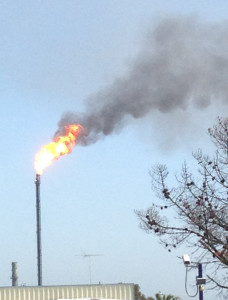
SUSTAINED FLARING at Valero Benicia Refinery drew the attention and concern of residents Tuesday.
Bruce Sundberg photos
Air Board: Flames actually ‘best possible alternative’
Flaring periodically occurs at all major refineries, and Valero Benicia Refinery is no exception.
But as regular as the occurrence may be, the sight of flames coming from the top of smokestacks sometimes alarms residents.
Flames from a Valero Benicia Refinery unit could be seen for miles Tuesday morning, and the resulting smoke cloud drifted south over Concord and other places in Contra Costa County.
However, nearby monitors detected no toxic materials, and no shelter-in-place order was issued.
“The Valero Refinery in Benicia, California is experiencing flaring after a compressor tripped on a unit,” said Sue Fisher Jones, refinery public affairs manager. “Work is under way to restart the unit.”
She said flares are regulated by the Bay Area Air Quality Management District (BAAQMD).
“In addition to flaring that can be visible to the community, steam used in the flaring process can create noise as gases are safely combusted,” she said.
Benicia Fire Chief Jim Lydon concurred, adding that the visible flames, called flaring, “is a normal reaction for the refinery when there is an occurrence such as this.”
He said his department had spoken Tuesday with Valero’s emergency staff. “There has been no event that would have resulted in injuries, our response, or a release requiring shelter-in-place orders.”
Aaron Richardson, senior public information officer of BAAQMD, said his agency had sent an inspector to monitor the flaring.
However, the district’s ground monitors placed near the refinery were detecting no hazardous chemicals that rose above existing regulatory standards, he said.
In fact, the flames that could be seen as far as Crockett in Contra Costa County and the Carquinez Bridge in Vallejo were doing their job to keep the refinery safe, he said.
“Flares are allowed throughout the year,” he said. Valero Benicia Refinery averages between five and 15 flares in most years, and they’re an accepted way of controlling and disposing of excess gas, he said.
The high temperatures generated during the flares incinerate gases, changing them from more hazardous composition into less toxic chemicals, he said. The heat sends the less harmful chemicals skyward.
“Refinery flares are designed and operated per federal, state and local standards,” Fisher Jones said.
 “Flares safely — and efficiently — burn gases, protecting employees, the community, and the environment.”
“Flares safely — and efficiently — burn gases, protecting employees, the community, and the environment.”
Fisher Jones didn’t say what types of chemical were released, and Richardson said the situation still was under examination. However, he said the flaring could have been a “safety release process” of sulfur dioxide or methane.
Sulfur dioxide can be a toxic gas, though it has been used for centuries in winemaking and also is used as a fruit preservative, a bleaching agent, a refrigerant and in water treatment plants.
Methane, the main component of natural gas, isn’t hazardous, Richardson said. “But it is a greenhouse gas,” he said.
Methane is considered a more potent greenhouse gas than carbon dioxide, and it is combustible. It’s used in electrical generation, burned to fuel turbines and boilers. In some places, it’s also used directly for heating and cooking.
He said BAAQMD air monitors detected no unusual quantities of either chemical during the flaring.
Richardson said the situation Tuesday at Valero had no comparison to the district’s discouragement of wood fires during the many “Spare the Air” days his agency issued during winter.
Wood fires cause fine particle pollution because their combustion isn’t complete, while refinery flaring releases little particulate matter, he said.
The Bay Area has 1.4 million fireplaces, and wood fires are blamed for 40 percent of the small particles that can create “serious health problems” and exceed regulatory standards, he said.
Richardson called flaring “a safety system” that is a less risky way for refineries to address a situation arising from malfunctioning equipment.
“If something is not working as intended, it’s the best possible alternative,” he said. “It’s the safety valve.”
He said burning the gases at the highest combustible level is preferable to fires or an uncontrolled release, or a buildup of gases at a refinery.
However, he said the BAAQMD inspector would be checking the refinery to determine if it had committed any violation.
“It will be investigated,” he said.






Leave a Reply